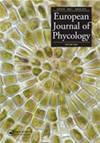Seasonal ecophysiology of Fucus vesiculosus (Phaeophyceae) in the Northern Baltic Sea
IF 1.7
4区 生物学
Q2 MARINE & FRESHWATER BIOLOGY
引用次数: 1
Abstract
ABSTRACT The brown macroalga Fucus vesiculosus is a foundation species in temperate rocky shores, subjected to seasonally fluctuating environmental conditions. To obtain a more complete picture of the seasonality of F. vesiculosus ecophysiology in the northern Baltic Sea, in situ photochemistry, elemental ratios and chlorophyll a and c content of the alga were investigated in field campaigns conducted in different months throughout the year during 2017. Carbon, nitrogen, carbon to nitrogen ratio and chlorophyll a and c content of the alga varied substantially throughout the year, with highest carbon content observed in summer, and highest nitrogen content in winter. C:N ratio in F. vesiculosus apical tissue ranged from 8.6 in February to 48.3 in July. Chlorophyll a and c content followed inversely the seasonal patterns of ambient irradiance. High chlorophyll a and c content in winter was associated with higher maximum photosynthetic efficiency of energy conversion (Fv/Fm), but not with efficiency of photosynthetic energy conversion under light limitation (α). Electron transport rate correlated strongly with seawater temperature, and the highest electron transport rates were observed in summer and correlated with highest internal carbon content of the alga. Redundancy analysis conducted on measured environmental variables against physiological responses identified day of year, temperature and macronutrients in seawater as the most important variables driving the observed seasonal patterns in F. vesiculosus ecophysiology. The results suggest elevated temperatures may increase Fucus growth and photosynthesis rates in the study area. Highlights Two distinct physiological states of Fucus vesiculosus were identified. The most important variables driving responses were season, temperature and macronutrients. Fucus ecophysiology shows substantial seasonality in the northern Baltic Sea.北波罗的海褐藻的季节性生理生态
摘要褐藻是温带岩石海岸的基础物种,受季节性波动的环境条件影响。为了更全面地了解波罗的海北部泡囊藻生态生理学的季节性,在2017年全年不同月份进行的实地调查中,对该藻类的原位光化学、元素比例以及叶绿素a和c含量进行了调查。藻类的碳、氮、碳氮比以及叶绿素a和c含量全年变化很大,夏季碳含量最高,冬季氮含量最高。C: 水疱性F.vesculosus顶端组织中N的比例从2月的8.6到7月的48.3不等。叶绿素a和c含量与环境辐照度的季节性模式相反。冬季高叶绿素a和c含量与较高的最大光合能量转换效率(Fv/Fm)有关,但与光照限制下的光合能量转化效率(α)无关。电子传输速率与海水温度密切相关,夏季电子传输速率最高,与藻类内部碳含量最高相关。对测量的环境变量与生理反应进行的冗余分析确定,海水中的温度和大量营养素是驱动泡囊藻生态生理学中观察到的季节模式的最重要变量。研究结果表明,温度升高可能会增加研究区域岩藻的生长和光合作用速率。亮点对泡状岩藻的两种不同的生理状态进行了鉴定。驱动反应的最重要变量是季节、温度和大量营养素。岩藻生态生理学在波罗的海北部表现出显著的季节性。
本文章由计算机程序翻译,如有差异,请以英文原文为准。
求助全文
约1分钟内获得全文
求助全文
来源期刊

European Journal of Phycology
生物-海洋与淡水生物学
CiteScore
4.80
自引率
4.20%
发文量
37
审稿时长
>12 weeks
期刊介绍:
The European Journal of Phycology is an important focus for the activities of algal researchers all over the world. The Editors-in-Chief are assisted by an international team of Associate Editors who are experts in the following fields: macroalgal ecology, microalgal ecology, physiology and biochemistry, cell biology, molecular biology, macroalgal and microalgal systematics, applied phycology and biotechnology. The European Journal of Phycology publishes papers on all aspects of algae, including cyanobacteria. Articles may be in the form of primary research papers and reviews of topical subjects.
The journal publishes high quality research and is well cited, with a consistently good Impact Factor.
 求助内容:
求助内容: 应助结果提醒方式:
应助结果提醒方式:


